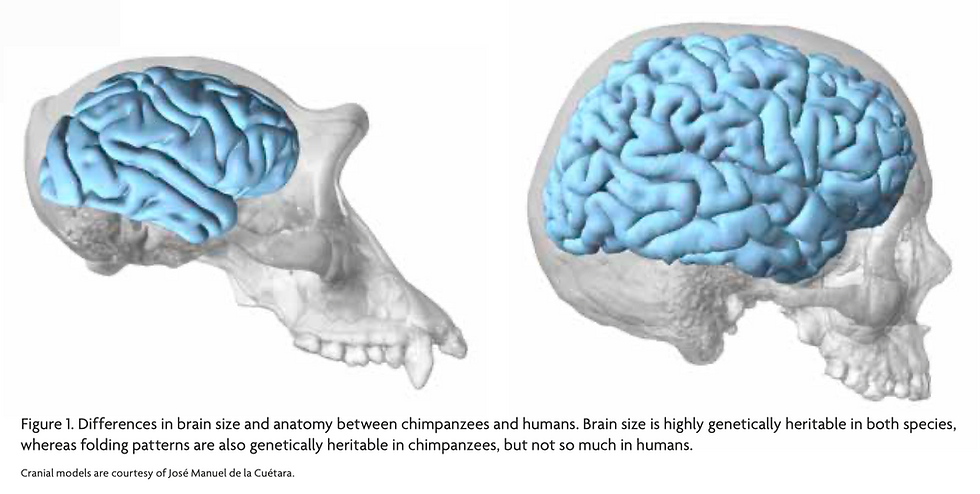Handedness and Neural Lateralization: Gestural Protolanguage in a New Perspective
- Wu, Bozhi

- Jun 1, 2019
- 5 min read
Updated: Mar 19, 2021

Common right-handedness and left-hemisphere lateralization of language faculties are two puzzling phenomena that have yet to be fully explained. As the human body is largely symmetrical, it is hard to think of the potential benefits that could result from these asymmetrical distributions of functions. More interestingly, as the likelihood of right-hemisphere or symmetric language dominance is significantly higher among people who are left-handed (Knecht, 2000; Szaflarski et al., 2002), a systematic association between those two asymmetries has long been suspected, and this connection has been frequently taken as a piece of evidence supporting the gestural protolanguage hypothesis of human language evolution. Therefore, in this paper, I would like to briefly introduce one version of the gestural protolanguage theory that is closely linked to this connection, which considers “tool-use” to be a central component in the language evolution process. In addition, I would also like to review several empirical studies that have provided compelling evidence for this hypothesis and suggest several directions for future research in the final conclusion section.
Numerous evolutionary theories have been proposed to explain the causal relationship between the emergence of human right-handedness and language evolution. Among them, I would like to mainly focus on the tool-use theory, which I personally consider to be the best-supported theory that exists nowadays. Basically, the tool-use theory suggests that our right-handedness to be a result of increased tool-use or increased complexity of manual activities in general in the hominoid lineage (Forrester & Quaresmini, 2013). According to Frost (1980), the skilled serial motor activities and the psychological capacity for hierarchical organization of movements required in the construction and use of tools might have paved a route for the evolution of the underlying structure of language, namely proto-grammar. In other words, after increased tool-use drove the lateralized cerebral specialization in producing temporal sequences of motor activities, proto-grammar and use of gestures have evolved, serving as a protolanguage and a preadaptation that allows the later exaptation of vocal language to take place. I personally prefer this theory of human handedness and language evolution as it not only provides a reasonable order of the development of handedness that fits the observations we have but also offers us a logical explanation for the emergence of proto-grammar, which is the prototype of syntax, the central feature of human language. Moreover, as we can see in the following section, a variety of evidence has either directly or indirectly supported this gestural protolanguage theory of human language evolution.

One stream of the evidence comes from the archeological and comparative studies on the homologous brain structures in early hominins and non-human primates, as these researches have provided support for the hypothesis that neural lateralization evolved earlier than our language faculties. For example, the cranial endocasts from Homo erectus have revealed larger left-hemisphere regions that correspond to the Broca’s area in modern humans (Holloway, 1980). Furthermore, more recent neuroimaging studies have indicated that chimpanzees, bonobos, gorillas, and orangutans all display homologous human Broca’s (Cantalupo, Pilcher, & Hopkins, 2003) and Wernicke’s (Spocter et al., 2010) areas to be asymmetrically larger in the left hemisphere. All these studies have suggested that this asymmetry of neural configuration originated prior to the presence of language and probably existed before our divergence from our last common ancestor with the great apes. Also, from a modern structural neural anatomical perspective, as Broca’s area is directly anterior to the brain regions in charge of the facial muscles and the hand muscles in the primary motor cortex (M1), it is reasonable to suspect the existence of an implicit link between these three closely-connected brain regions in the evolutionary process.
Another stream of evidence comes from behavioral studies and behavioral neuroscience research on the specific functions of those related brain regions. Surprisingly, those areas in the left hemisphere that are typically considered to be only in charge of language production and comprehension have been found to be involved in comprehending and producing signs as well (Corina, Vaid, & Bellugi, 1992; Grossi, Semenza, Corazza, & Volterra, 1996). These results suggest that those brain regions are not modality specific and a shared neurobiological system is probably involved in both manual and vocal languages. Based on these findings, Hopkins and Cantero’s (2003) have designed an experiment where they observe and record chimpanzees’ gestures and vocalizations when they intend to get a banana out of their immediate reach from the experimenter. What they hypothesized was that right-handed manual gestures should be more prevalent when they are accompanied by vocalization, as they probably share some common underlying neurobiological computations.The data they have collected has not only supported their hypothesis but also revealed chimpanzees’ preferential use of the right hand in gestural communication in general. This result has suggested the implicit association between gestures and vocalization, potentially shedding light upon the transition from gestural to multimodal communication in the evolutionary process. Furthermore, in support of the tool-use theory, an fMRI study on healthy humans have demonstratedan overlap of brain activity for using tools and perceiving language in the Broca’s area (Higuchi, Chaminade, Imamizu, & Kawato, 2009), which has directly confirmed the hypothesized neural and computational commonality underlying tool-use and language processing.

To conclude, evidence from a variety of disciplines and researches have provided support for the gestural protolanguage hypothesis and the tool-use theory specifically. To date, I consider this to be the best theory we have for explaining the close association we have observed between handedness and neural lateralization of our language faculties. Nevertheless, this is by no means suggesting that this is a complete theory without problems. Instead, valid criticisms exist and there are still several important questions remaining to be answered. For example, the brain regions that are activated during alarm call and gestural communication among non-human primates and monkeys could be investigated applying neuroimaging technologies. If the gestural protolanguage hypothesis is correct, then a certain level of activation in the homologue of Broca’s area and Wernicke’s area should be observed during gestural communication. Also, further studies are needed to investigate whether a certain level of syntactic or hierarchical organization exists among ape gestures, as hypothesized by the gestural protolanguage theory. And most importantly, the critical question of what has driven the shift from manual modality to vocal modality of communication requires a reasonable answer, as the success of sign languages has suggested the possibility of evolving a complete language system independent of any vocal components (Fitch, 2010). Therefore, a more satisfactory additional theory is needed for us to explain the significant benefit of vocal comparing to manual modality of communication and therefore why human vocal language has evolved.
References
Cantalupo, C., Pilcher, D. L., & Hopkins, W. D. (2003). Are planum temporale and sylvian fissure asymmetries directly related? Neuropsychologia, 41(14), 1975–1981. https://doi.org/10.1016/S0028-3932(02)00288-9
Corina, D. P., Vaid, J., & Bellugi, U. (1992). The linguistic basis of left hemisphere specialization. Science,255, 1258–1260.
Fitch, W. T. (2010). The Evolution of Language. Cambridge University Press.
Forrester, G. S., & Quaresmini, C. (2013). The right hand man: Manual laterality and language. In D. Csermely & L. Regolin (Eds.), Behavioral lateralization in vertebrates(pp. 125–141). https://doi.org/10.1007/978-3-642-30203-9_9
Frost, G. T. (1980). Tool behavior and the origins of laterality. Journal of Human Evolution, 9, 447–459.
Grossi, G., Semenza, C., Corazza, S., & Volterra, V. (1996). Hemispheric specialization for sign language. Neuropsychologia,34(7), 737–740. https://doi.org/10.1016/0028-3932(96)00008-5
Higuchi, S., Chaminade, T., Imamizu, H., & Kawato, M. (2009). Shared neural correlates for language and tool use in Brocaʼs area. NeuroReport, 20(15), 1376–1381. https://doi.org/10.1097/WNR.0b013e3283315570
Holloway, R. L. (1980). Indonesian “Solo” (Ngandong) endocranial reconstructions: Some preliminary observations and comparisons with Neandertal and Homo erectusgroups. American Journal of Physical Anthropology, 53(2), 285–295. https://doi.org/10.1002/ajpa.1330530213
Knecht, S. (2000). Handedness and hemispheric language dominance in healthy humans. Brain, 123(12), 2512–2518. https://doi.org/10.1093/brain/123.12.2512
Spocter, M. A., Hopkins, W. D., Garrison, A. R., Bauernfeind, A. L., Stimpson, C. D., Hof, P. R., & Sherwood, C. C. (2010). Wernicke’s area homologue in chimpanzees (Pan troglodytes) and its relation to the appearance of modern human language. Proceedings of the Royal Society B: Biological Sciences, 277(1691), 2165–2174. https://doi.org/10.1098/rspb.2010.0011
Szaflarski, J. P., Binder, J. R., Possing, E. T., McKiernan, K. A., Ward, B. D., & Hammeke, T. A. (2002). Language lateralization in left-handed and ambidextrous people: fMRI data. Neurology,59(2), 238–244. https://doi.org/10.1212/WNL.59.2.238







Comments